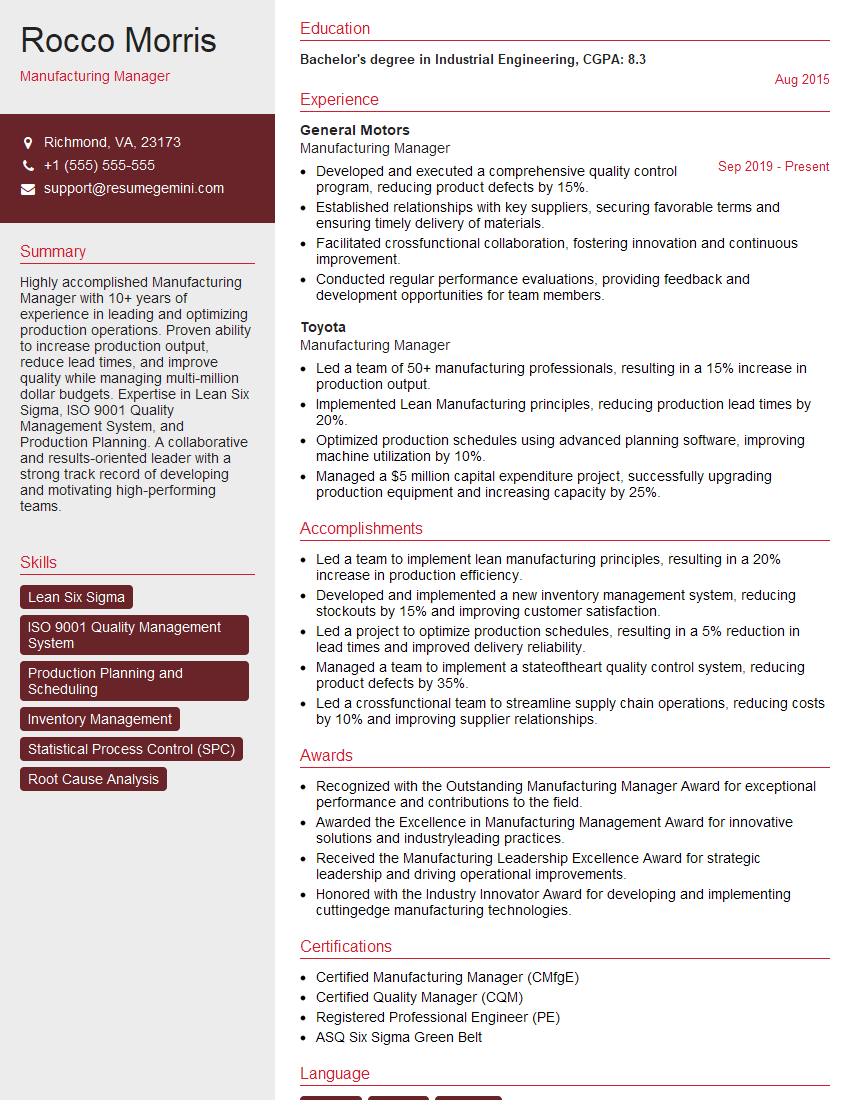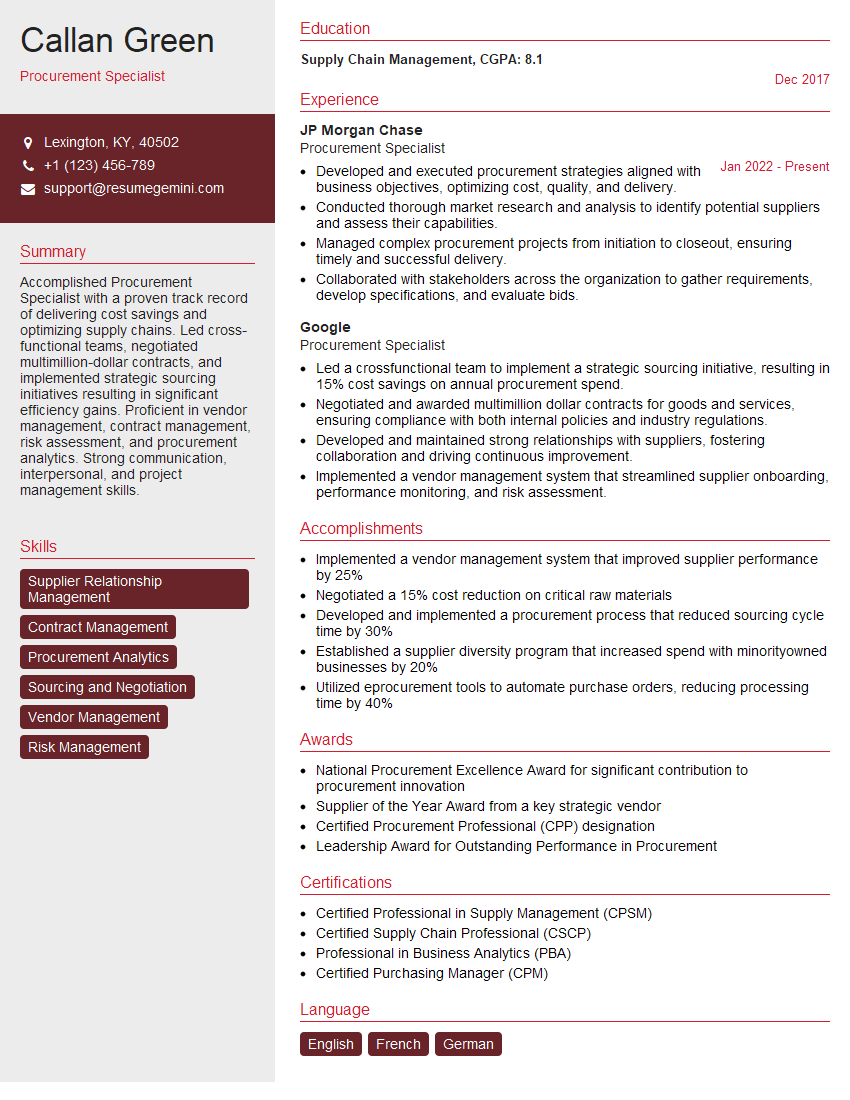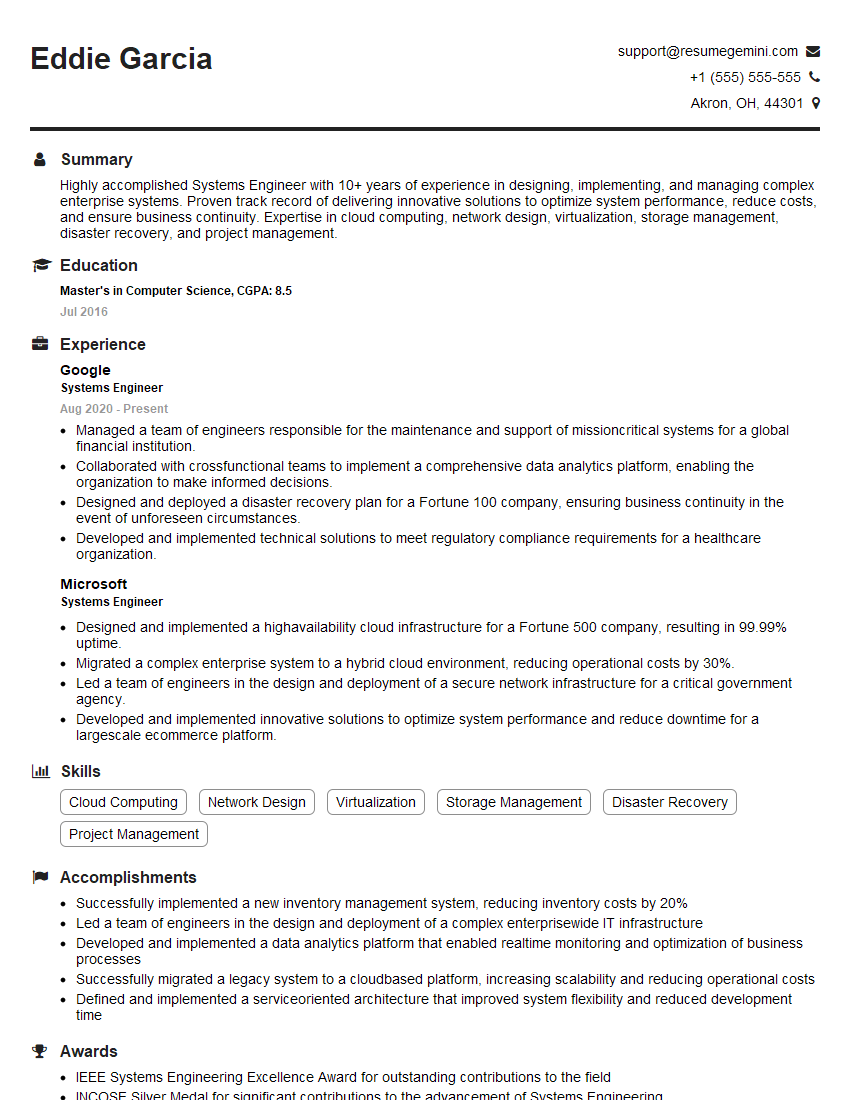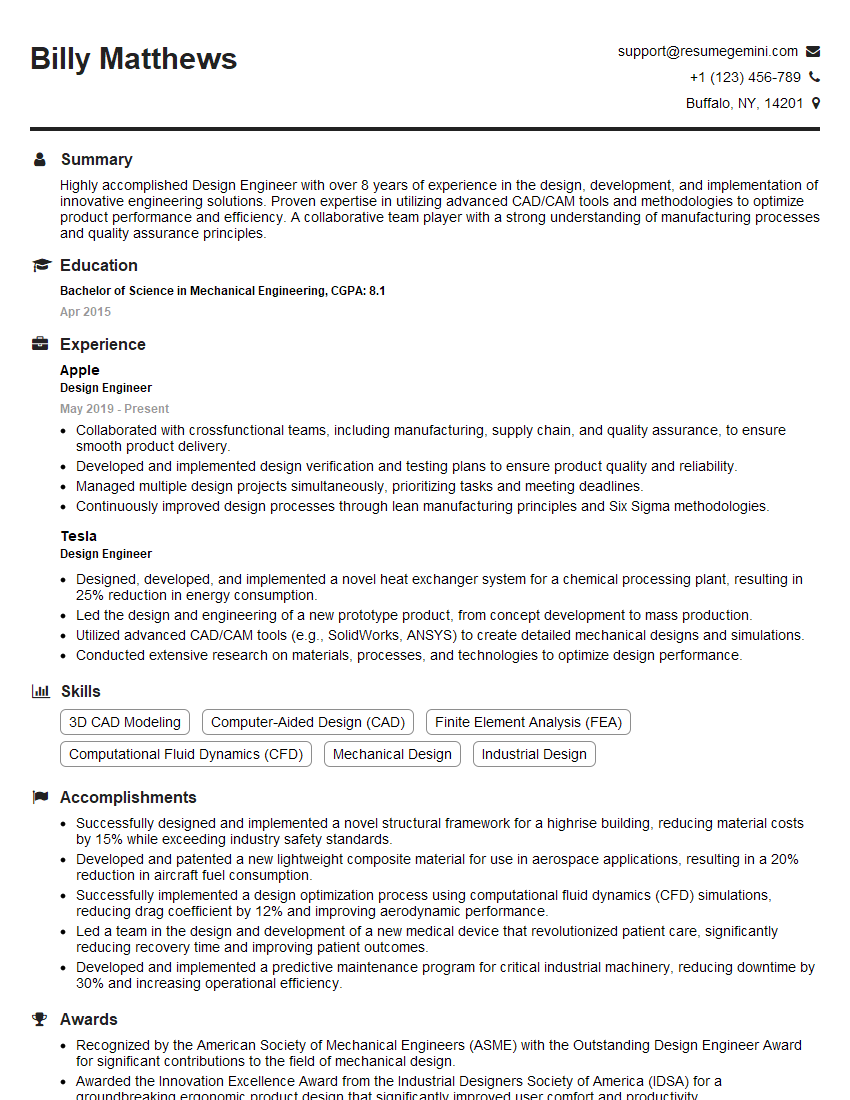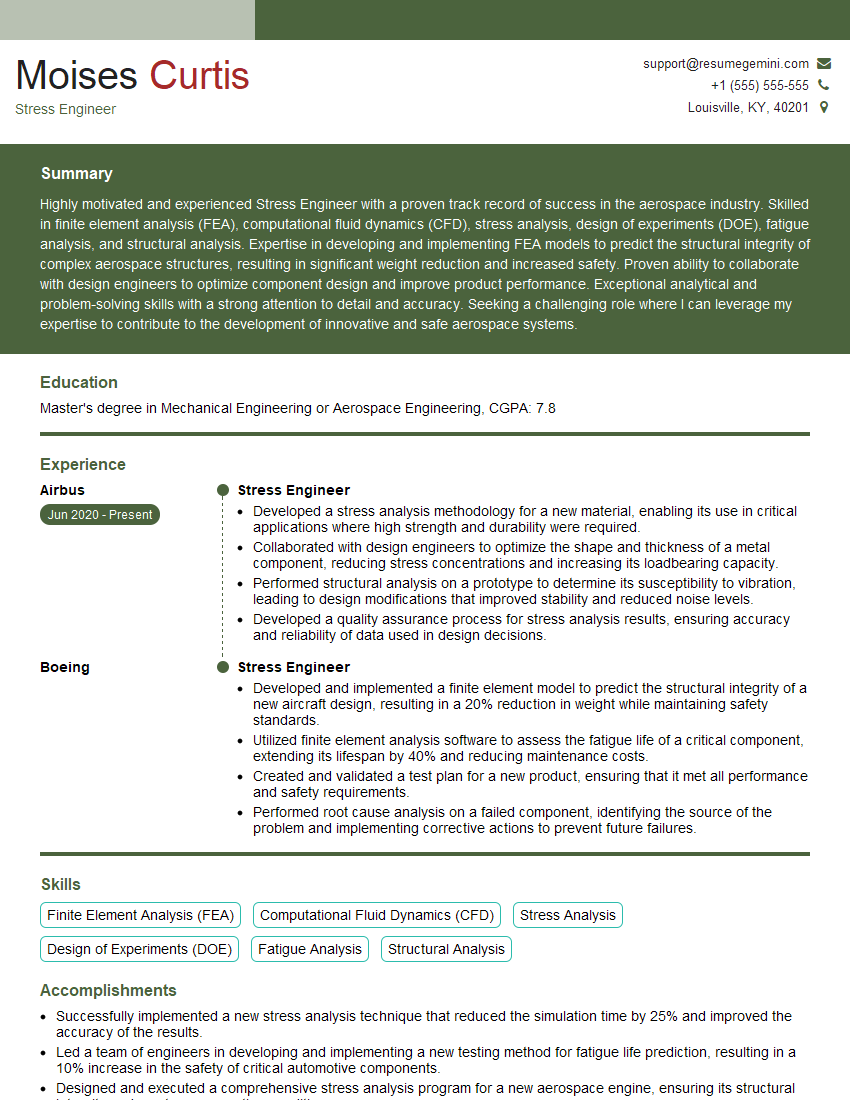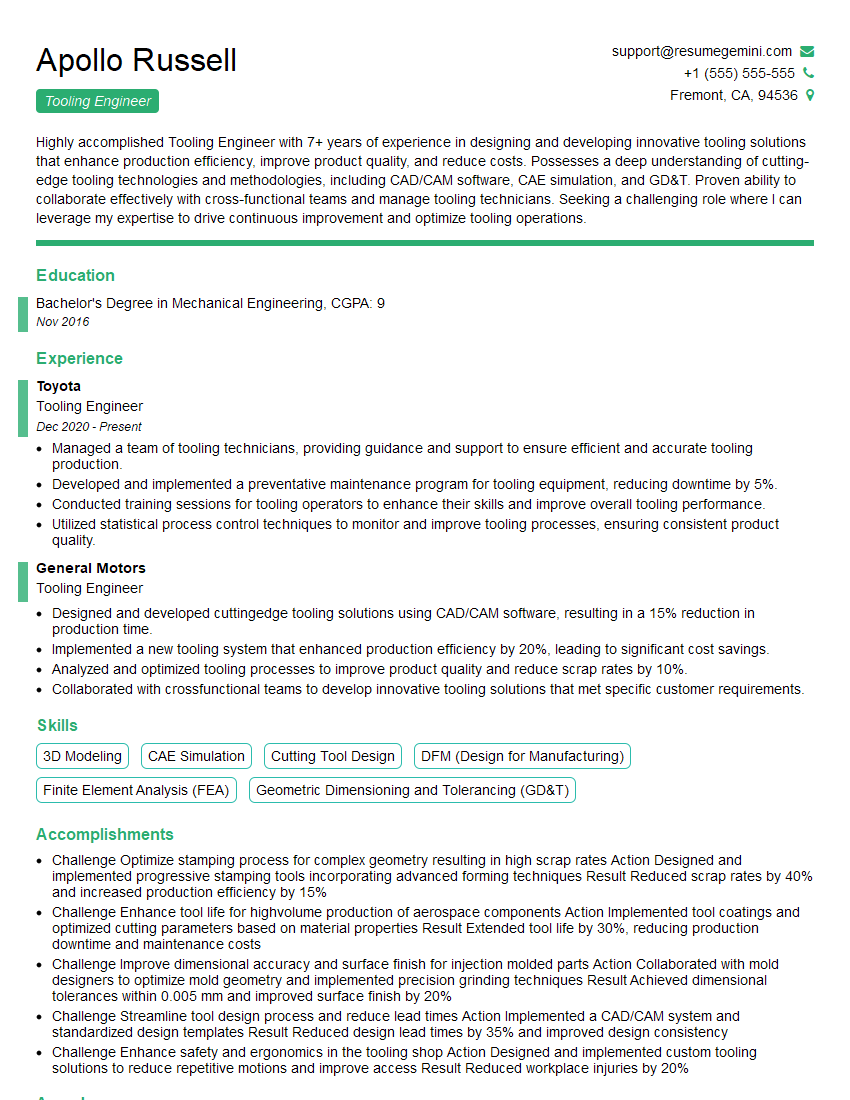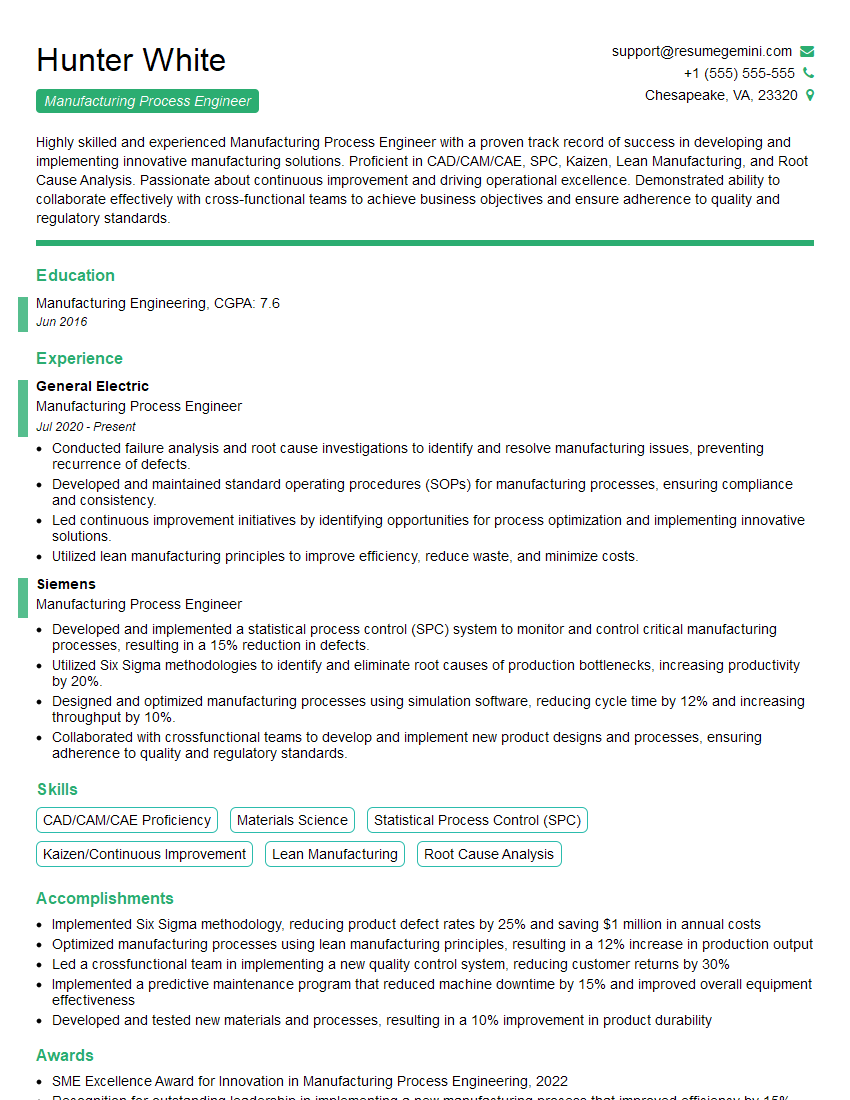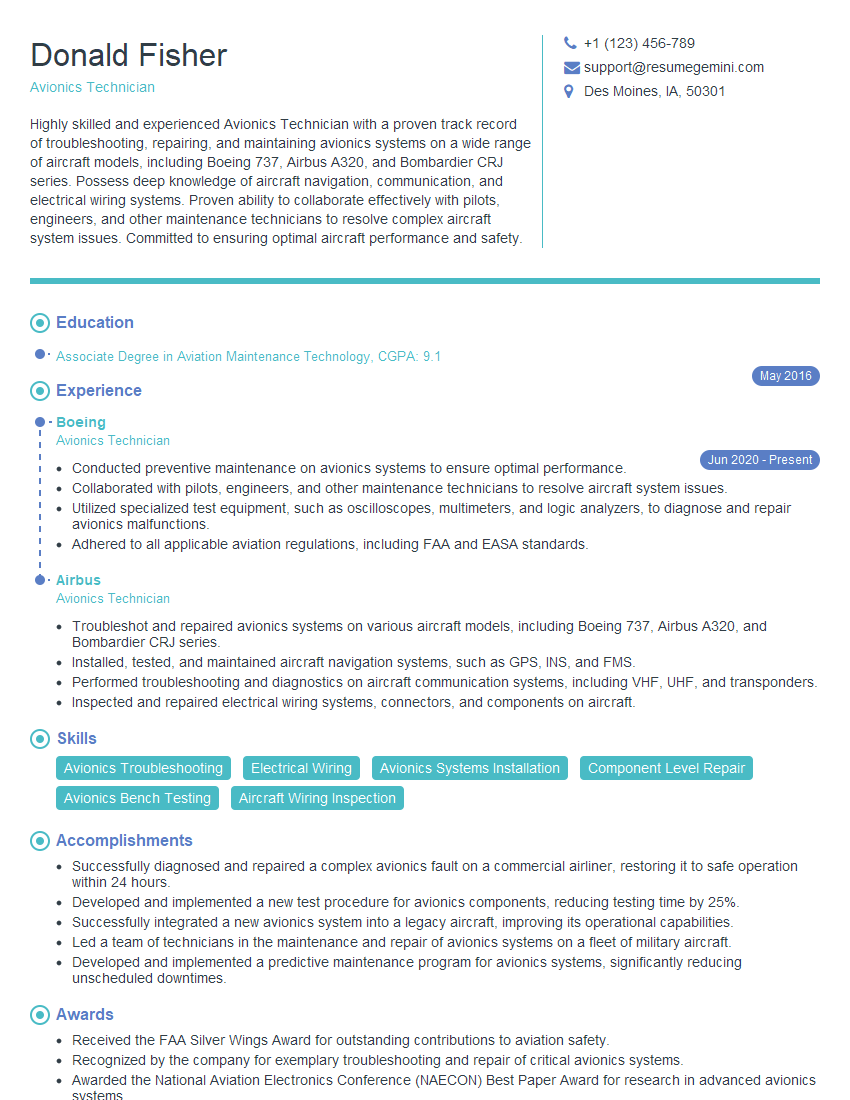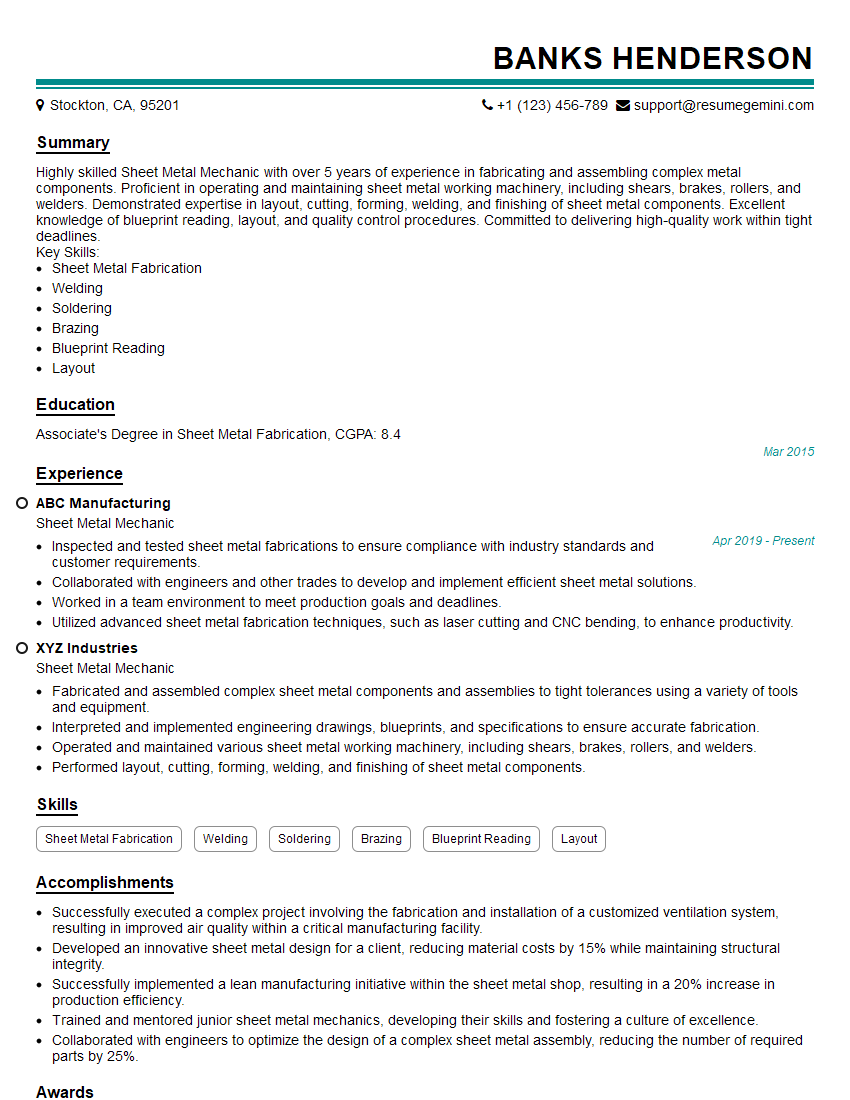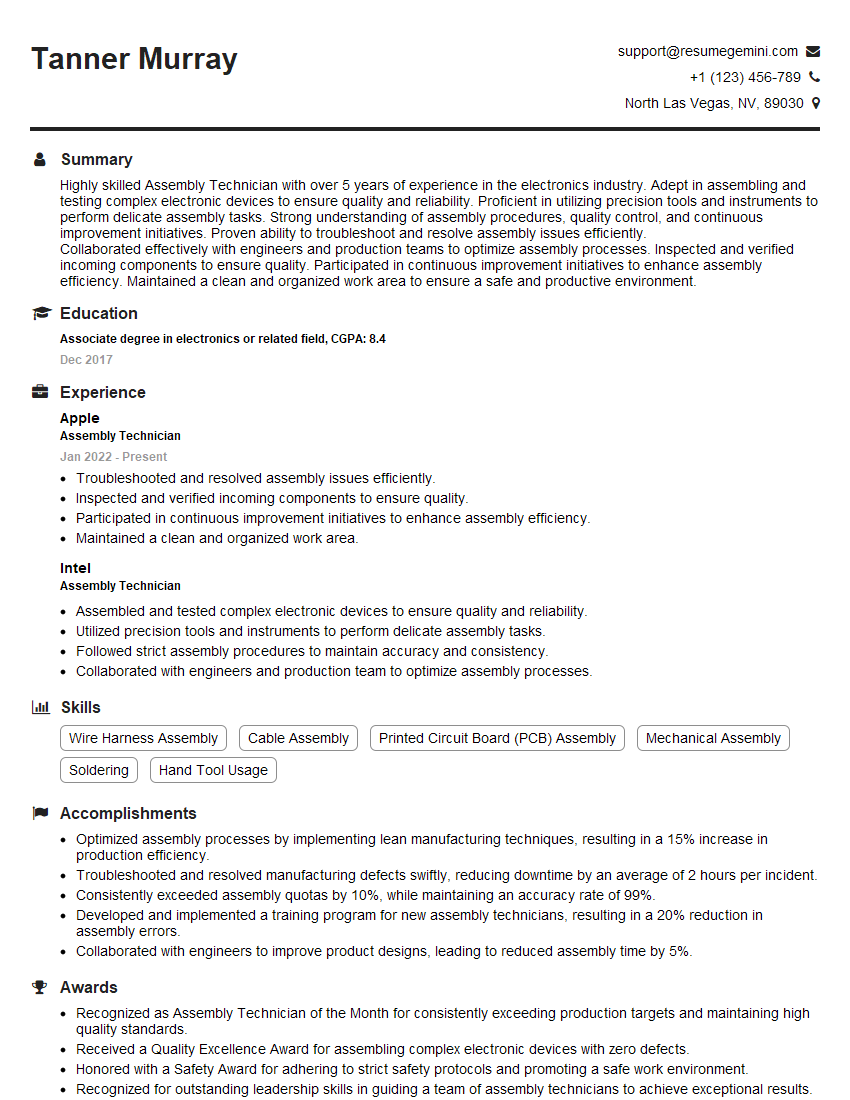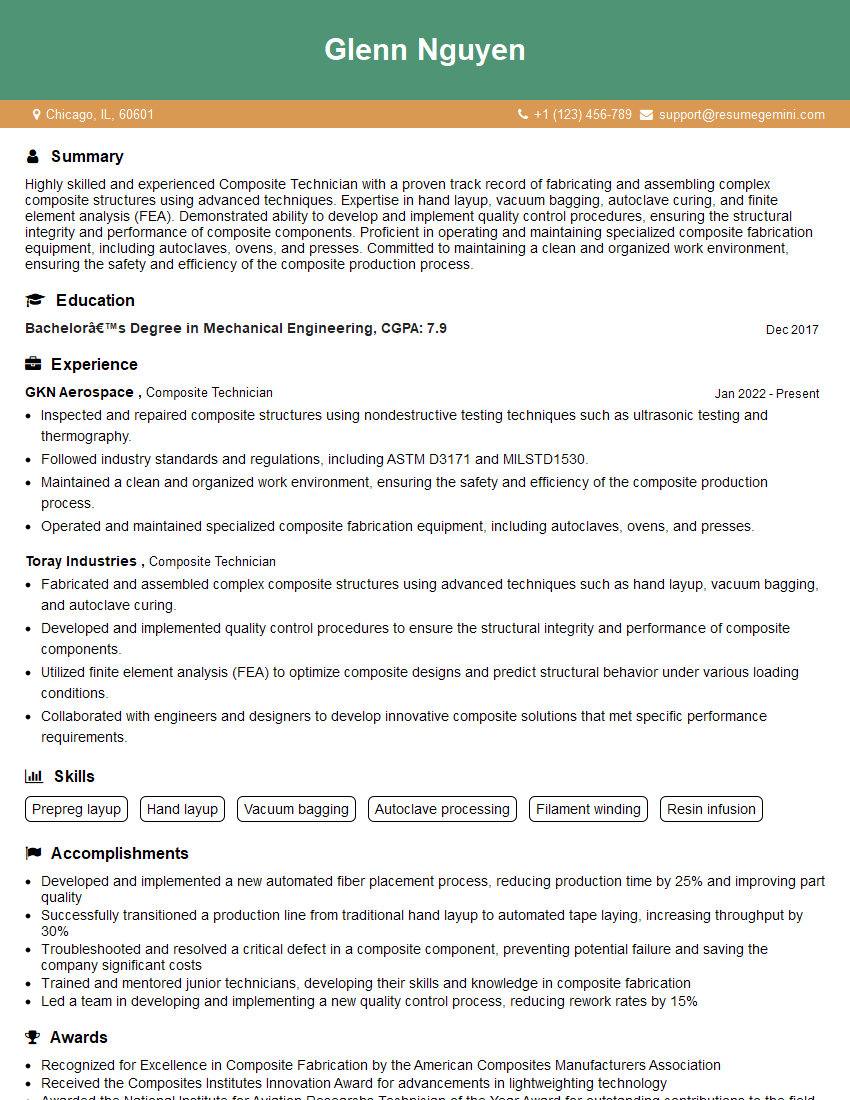The thought of an interview can be nerve-wracking, but the right preparation can make all the difference. Explore this comprehensive guide to Experience in Aircraft Manufacturing interview questions and gain the confidence you need to showcase your abilities and secure the role.
Questions Asked in Experience in Aircraft Manufacturing Interview
Q 1. Explain your experience with different aircraft manufacturing processes (e.g., riveting, welding, bonding).
My experience encompasses a wide range of aircraft manufacturing processes, each crucial for building safe and reliable aircraft. Think of it like building with incredibly precise LEGOs, but on a massive scale. Let’s look at three key processes:
- Riveting: This is a fundamental joining technique, especially for aluminum airframes. It involves using specialized tools to mechanically fasten metal sheets together with rivets. I’ve been involved in everything from manual riveting on smaller components to working with automated riveting systems for larger sections of the fuselage. The precision required is paramount; a poorly placed rivet can compromise structural integrity. For example, on one project, I oversaw the riveting of wing spars, where even minor deviations could affect the aircraft’s lift and stability.
- Welding: Welding, particularly TIG welding, is often used for joining titanium and high-strength steel components where high strength and resistance to corrosion are crucial. I’ve worked extensively with this process, ensuring proper weld penetration and bead quality. A flaw here can lead to catastrophic failure, so stringent quality checks are essential. Think of it like perfectly fusing two metal pieces together so seamlessly they act as one.
- Bonding: This process involves joining components using adhesives, often used extensively with composite materials. I’ve experienced various bonding techniques, from simple adhesive applications to more complex processes using prepreg materials in autoclaves. The success of bonding hinges on surface preparation, precise adhesive application, and strict curing parameters. Incorrect bonding can result in delamination and reduced strength. On a recent project, I was responsible for overseeing the bonding of composite panels for a new aircraft wing, where ensuring proper cure cycles was vital for meeting required strength parameters.
Q 2. Describe your experience with Quality Control procedures in aircraft manufacturing.
Quality control (QC) in aircraft manufacturing isn’t just about meeting standards; it’s about ensuring safety. It’s a multi-layered process involving meticulous inspection at every stage. Think of it like a continuous quality check on a manufacturing assembly line, only more demanding and precise.
- In-process inspections: Throughout the manufacturing process, components undergo rigorous inspections. This includes dimensional checks, material testing, and visual inspections for defects. I’ve been personally involved in performing these checks, using various tools like CMM (Coordinate Measuring Machines) and ultrasonic testing equipment.
- Non-destructive testing (NDT): This involves methods like radiography, ultrasonic inspection, and liquid penetrant inspection, which identify hidden flaws without damaging the component. I have extensive experience interpreting NDT results and determining the acceptability of parts. A crack, for instance, that goes undetected can be disastrous.
- Final assembly inspection: Once all components are assembled, a final inspection ensures that the aircraft meets all design specifications and safety standards. This stage involves a thorough review of all systems and functionalities, often culminating in a flight test.
My experience includes implementing and improving QC processes to reduce defects and ensure compliance with industry regulations. For instance, I developed a new inspection checklist for a specific component that resulted in a 20% reduction in rework.
Q 3. How familiar are you with industry standards like AS9100?
AS9100 is the international quality management systems standard specifically designed for the aerospace industry. I’m extremely familiar with AS9100, having worked in organizations certified to this standard. It’s not just a set of guidelines; it’s a framework that ensures consistent quality and safety throughout the entire manufacturing process. Think of it like a comprehensive instruction manual for building aircraft to the highest safety and quality standards.
My knowledge extends to understanding and implementing the requirements of AS9100, including aspects like risk management, continuous improvement, and supplier management. In my previous role, I actively participated in internal audits and helped our organization maintain AS9100 certification. Understanding AS9100 is vital for ensuring that our aircraft meet the stringent safety requirements demanded by the industry.
Q 4. Explain your experience with different aircraft materials (e.g., aluminum, composites, titanium).
Aircraft manufacturing utilizes a range of materials, each selected for its specific properties. The choice of material greatly influences the aircraft’s performance, weight, and cost. Think of it like a chef selecting ingredients based on their flavors and textures to create a delicious dish.
- Aluminum alloys: These are widely used due to their lightweight yet strong nature. I’ve worked extensively with various aluminum alloys, understanding their strengths and limitations, such as susceptibility to corrosion.
- Composites: These materials, like carbon fiber reinforced polymers (CFRP), offer high strength-to-weight ratios, crucial for fuel efficiency. My experience includes working with composite materials, from prepreg layup to autoclave curing. These require precise handling and curing to prevent defects.
- Titanium alloys: These materials are used in high-stress applications due to their high strength and corrosion resistance. I have familiarity with their unique characteristics and the specialized welding techniques required for their fabrication.
Understanding the properties and limitations of these materials is critical for designing and manufacturing durable and lightweight aircraft structures. For example, I recently worked on a project that involved selecting the optimal composite material for a new wing design, balancing strength, weight, and cost considerations.
Q 5. Describe your experience with CAD/CAM software in aircraft manufacturing.
CAD/CAM software is integral to modern aircraft manufacturing. Think of it as the blueprint and the instruction manual combined, allowing for precise design and manufacturing. My experience includes extensive use of software like CATIA, NX, and SolidWorks.
I’ve used CAD software for designing and modeling aircraft components, from detailed parts to entire assemblies. I’ve also used CAM software to generate CNC machining programs for manufacturing parts with extreme accuracy. For example, I’ve designed and manufactured complex titanium parts using five-axis CNC milling machines. The use of these software packages allows for efficient design iteration, reduces manufacturing errors, and streamlines the production process.
Q 6. How do you ensure adherence to safety regulations in aircraft manufacturing?
Adherence to safety regulations in aircraft manufacturing is non-negotiable. It’s not just about following rules; it’s about a commitment to safety at every level. Think of it as a multi-layered safety net, with each layer contributing to the overall safety of the aircraft.
- Regulatory compliance: This involves understanding and complying with regulations set by agencies like the FAA (Federal Aviation Administration) and EASA (European Union Aviation Safety Agency). I’ve been involved in documentation and compliance processes, ensuring that all our work aligns with these strict regulations.
- Safety procedures: Following strict safety protocols and guidelines is essential during manufacturing. This includes using proper safety equipment, implementing hazard analysis, and reporting any safety concerns immediately.
- Quality checks: Rigorous quality control measures are integral to safety. Through inspections and testing, we identify and rectify potential safety hazards before they become problems.
My experience includes developing and implementing safety procedures, participating in safety audits, and training personnel on safe work practices. A commitment to safety isn’t just a policy; it’s a culture we embed in every aspect of our work.
Q 7. Describe your experience with Lean Manufacturing principles.
Lean manufacturing principles focus on eliminating waste and maximizing efficiency in the manufacturing process. Think of it like streamlining a kitchen to make cooking more efficient and less wasteful. In aircraft manufacturing, this translates to significant cost savings and improved production times.
- Value stream mapping: Identifying and eliminating non-value-added steps in the production process. I’ve used this technique to optimize workflows and reduce lead times.
- Kaizen (continuous improvement): Implementing small, incremental improvements to continuously enhance efficiency. I’ve actively participated in Kaizen events, identifying and resolving bottlenecks in the manufacturing process.
- 5S methodology: Organizing the workplace to improve efficiency and safety. I’ve implemented 5S principles (Sort, Set in Order, Shine, Standardize, Sustain) in my previous roles, resulting in a more organized and efficient work environment.
Implementing lean principles isn’t just about improving efficiency; it directly impacts quality and safety by reducing errors and improving consistency. In one project, implementing lean manufacturing techniques reduced production time by 15% while simultaneously improving quality metrics.
Q 8. How do you troubleshoot manufacturing problems and identify root causes?
Troubleshooting manufacturing problems requires a systematic approach. I typically employ a structured methodology like the 5 Whys or a Fishbone diagram (Ishikawa diagram) to identify the root cause. This involves gathering data from various sources – inspection reports, production logs, operator feedback, and even examining the defective part itself.
For example, if we find a batch of improperly riveted wing sections, I wouldn’t just stop at identifying the faulty rivets. I’d use the 5 Whys:
- Why are the rivets improperly installed? Because the rivet gun malfunctioned.
- Why did the rivet gun malfunction? Because it wasn’t properly calibrated.
- Why wasn’t it calibrated? Because the calibration schedule wasn’t followed.
- Why wasn’t the schedule followed? Because of insufficient training for the maintenance team.
- Why was there insufficient training? Because the training budget was cut.
This reveals the root cause – inadequate training due to budget constraints – allowing for targeted corrective actions, rather than simply replacing the rivets.
The Fishbone diagram helps visualize contributing factors simultaneously, leading to a more holistic understanding of the problem.
Q 9. Explain your experience with managing production schedules and deadlines.
Managing production schedules in aircraft manufacturing is critical. I’ve successfully employed techniques like Critical Path Method (CPM) and Program Evaluation and Review Technique (PERT) to manage complex projects with tight deadlines. These methods help identify tasks crucial to meeting the overall deadline and highlight potential delays.
In one project, we faced a delay in the delivery of a crucial engine component. Using PERT, we analyzed the impact on the overall schedule, identified alternative suppliers, and negotiated expedited shipping, minimizing the overall project delay to only a week, instead of the projected three.
I also utilize software like MS Project to track progress, allocate resources, and manage potential conflicts. Regular meetings with the team, suppliers, and stakeholders are crucial for effective communication and proactive problem-solving.
Q 10. How do you manage a team in a high-pressure manufacturing environment?
Managing a team in a high-pressure environment requires strong leadership, clear communication, and a focus on team empowerment. I prioritize open dialogue, fostering a culture where team members feel comfortable voicing concerns and offering solutions. I believe in delegating effectively based on individual strengths and providing constructive feedback and training opportunities.
For instance, during a critical assembly phase, I noticed one team member struggling with a new welding technique. Instead of criticizing, I paired them with a more experienced welder for mentorship. This resulted not only in improved performance from that individual but also boosted team morale and knowledge sharing.
Regular team meetings, celebrating successes, and addressing challenges openly are essential to maintain a positive and productive atmosphere, even under pressure.
Q 11. Describe your experience with different types of aircraft assembly.
My experience encompasses various aircraft assembly processes, including both fuselage and wing assembly. I’ve worked on projects involving both traditional methods and more advanced techniques like automated riveting and composite material bonding. I’m familiar with the intricacies of different aircraft designs, from smaller regional jets to larger commercial airliners.
Specifically, I’ve been involved in the assembly of Boeing 737 and Airbus A320 family aircraft, managing teams responsible for various stages, from sub-assembly of components to final assembly and systems integration. This includes experience with different materials – aluminum alloys, titanium, and composites – and associated quality control procedures.
Q 12. How familiar are you with different types of aircraft engines?
I possess a solid understanding of various aircraft engine types, including turbofan, turboprop, and turbojet engines. I’m familiar with the manufacturers, such as Rolls-Royce, GE Aviation, Pratt & Whitney, and CFM International, and their respective engine models. My knowledge extends beyond basic engine types to encompass the intricacies of engine components, maintenance procedures, and performance characteristics.
Understanding engine specifications is critical in aircraft manufacturing as it directly impacts the overall design and functionality of the aircraft. This includes considerations for weight, thrust, fuel efficiency, and noise levels.
Q 13. What is your experience with aircraft maintenance procedures?
My experience with aircraft maintenance procedures aligns closely with industry best practices and regulatory compliance, such as FAA regulations. I understand the importance of meticulous record-keeping, adherence to maintenance schedules, and thorough inspection protocols. I’m familiar with various maintenance tasks, including preventative maintenance, corrective maintenance, and troubleshooting of mechanical and electrical systems.
For example, I have experience in managing the implementation of computerized maintenance management systems (CMMS) to enhance efficiency and track maintenance history. This allows for better prediction and prevention of potential issues, improving overall aircraft reliability and safety.
Q 14. How do you ensure timely delivery of aircraft parts and components?
Ensuring timely delivery of aircraft parts and components requires a proactive approach to supply chain management. This includes establishing strong relationships with suppliers, implementing robust inventory management systems, and employing risk mitigation strategies. I utilize techniques like Just-In-Time (JIT) inventory management to minimize storage costs and reduce the risk of obsolete parts.
I actively monitor supplier performance through key performance indicators (KPIs), such as on-time delivery rates and quality metrics. In cases of potential delays, I work closely with suppliers to identify solutions, such as expedited shipping or alternative sourcing options, to ensure minimal impact on the overall production schedule.
Q 15. How do you manage inventory levels in an aircraft manufacturing facility?
Managing inventory in aircraft manufacturing is a complex balancing act. It’s crucial to ensure we have the right parts, at the right time, in the right quantity, without tying up excessive capital in storage. We utilize a sophisticated Material Requirements Planning (MRP) system that forecasts demand based on production schedules and lead times for each component. This system considers factors like potential delays, planned maintenance, and even historical usage patterns.
For example, we might use ABC analysis to categorize parts based on their value and criticality. ‘A’ items (high value, high criticality) receive extremely close monitoring, with potentially just-in-time delivery from suppliers. ‘C’ items (low value, low criticality) are managed with larger safety stocks to avoid disruptions. We also regularly review inventory levels to identify potential obsolescence and adjust our ordering accordingly, minimizing waste and storage costs. This process involves close collaboration with our procurement and logistics teams to ensure smooth supply chain management.
Furthermore, regular audits and inventory reconciliation ensure the accuracy of our records. Discrepancies are investigated to identify root causes and implement corrective actions to prevent future errors. This precise inventory control is critical because delays in getting even a single, seemingly insignificant part can ground an entire production line, significantly impacting costs and deadlines.
Career Expert Tips:
- Ace those interviews! Prepare effectively by reviewing the Top 50 Most Common Interview Questions on ResumeGemini.
- Navigate your job search with confidence! Explore a wide range of Career Tips on ResumeGemini. Learn about common challenges and recommendations to overcome them.
- Craft the perfect resume! Master the Art of Resume Writing with ResumeGemini’s guide. Showcase your unique qualifications and achievements effectively.
- Don’t miss out on holiday savings! Build your dream resume with ResumeGemini’s ATS optimized templates.
Q 16. Explain your experience with different types of manufacturing equipment.
My experience encompasses a wide range of manufacturing equipment, from traditional machining centers like CNC milling machines and lathes to advanced robotic systems and additive manufacturing technologies. I’ve worked extensively with automated fiber placement (AFP) machines for composite layup, which offer significant advantages in terms of speed, accuracy, and repeatability compared to manual methods. I’m also familiar with various types of riveting machines, automated inspection systems (including non-destructive testing equipment), and sophisticated painting booths designed to meet stringent environmental standards.
In one project, we integrated a new generation of robotic arms for automated drilling and fastening. This improved efficiency by 20% and reduced the risk of human error. Similarly, I’ve overseen the implementation of 3D printing (additive manufacturing) for the production of complex tooling and jigs. This allowed us to significantly reduce lead times and production costs for customized parts.
My experience includes hands-on operation, maintenance, and troubleshooting of this equipment, in addition to overseeing its integration into the overall manufacturing process. I understand the importance of regular maintenance to optimize performance and minimize downtime, as well as the safety protocols that are essential to protect our workforce.
Q 17. Describe your experience with implementing new technologies in aircraft manufacturing.
Implementing new technologies is a continuous process in aircraft manufacturing. I’ve been involved in several projects that integrated digital twins, advanced simulation software, and data analytics to optimize production workflows. One notable project involved implementing a digital twin of our assembly line, allowing us to virtually test and optimize the layout and processes before physical implementation. This reduced costly rework and improved efficiency. Another initiative involved leveraging data analytics to predict potential equipment failures, enabling proactive maintenance and minimizing downtime.
We also implemented augmented reality (AR) systems to guide technicians during complex assembly tasks, providing real-time instructions and reducing errors. The transition involved extensive training for our workforce, ensuring they could effectively utilize the new technologies and understand the associated safety protocols. Change management is critical, and successful implementation relies on clear communication, adequate training, and addressing concerns of those impacted by the change. The results have been a measurable increase in productivity and a reduction in defects.
I’m always actively evaluating new technologies and exploring their potential to streamline operations, enhance quality, and improve safety within our facilities.
Q 18. How do you handle conflicts or disagreements within a team?
Conflict resolution is an essential skill in any team environment, particularly in a high-stakes industry like aircraft manufacturing. My approach centers around open communication and collaborative problem-solving. I start by actively listening to all perspectives involved in the disagreement, ensuring everyone feels heard and understood. It’s crucial to remain neutral and focus on the issue at hand, avoiding personal attacks or emotional responses.
I often facilitate brainstorming sessions to explore different solutions, encouraging a collaborative approach. We aim to identify a solution that is mutually acceptable and addresses the root cause of the conflict. If a compromise can’t be reached immediately, I might suggest a structured approach such as mediation, allowing a neutral third party to help guide the conversation and facilitate a solution. Documentation of the conflict and its resolution is important for tracking and learning from these experiences. The goal is always to resolve the issue constructively, reinforcing teamwork and improving communication within the team.
Q 19. Describe your experience with risk management in aircraft manufacturing.
Risk management is paramount in aircraft manufacturing, given the high safety standards and potential consequences of failures. We utilize a structured risk management process that includes identifying potential hazards, assessing their likelihood and severity, developing mitigation strategies, and regularly monitoring their effectiveness. This involves using various tools such as Failure Mode and Effects Analysis (FMEA) and Fault Tree Analysis (FTA).
For instance, when introducing a new manufacturing process, we conduct a thorough FMEA to identify potential points of failure and develop preventive measures. This might include implementing redundancy in critical systems, improving training protocols, or investing in advanced inspection equipment. Regular safety audits and reviews ensure that the implemented risk mitigation strategies remain effective and are adapted as needed. Continuous improvement is vital to proactively address emerging risks and maintain the highest safety standards, minimizing potential hazards and improving overall safety performance.
Q 20. Explain your experience with cost control and budget management in manufacturing.
Cost control and budget management are critical in the aircraft manufacturing industry, which is characterized by high capital expenditures and long lead times. We employ a robust system of cost accounting, tracking expenses across various phases of the project lifecycle, from design and procurement to manufacturing and delivery. This system allows for accurate budgeting, forecasting, and cost variance analysis.
We use various techniques such as value engineering to identify cost-saving opportunities without compromising quality or safety. Regular budget reviews involve analyzing actual costs against planned costs, identifying deviations, and implementing corrective actions to stay within budget. This process often involves close collaboration with project managers, procurement teams, and other stakeholders to identify areas for optimization and cost reduction. Transparency and accountability are key to ensuring effective cost control and budget management throughout a project.
Q 21. How do you stay updated on the latest advancements in aircraft manufacturing?
Staying updated on the latest advancements in aircraft manufacturing is crucial for maintaining a competitive edge. I achieve this through a combination of strategies: I regularly attend industry conferences and trade shows, networking with peers and experts, and learning about cutting-edge technologies and best practices. I also actively subscribe to industry publications, journals, and online resources, staying informed about the latest research and developments. This also includes participating in webinars and online courses offered by industry leaders and professional organizations.
Furthermore, I actively participate in professional organizations, such as SAE International, contributing to discussions and learning from colleagues. Continuous learning and professional development are essential for staying abreast of evolving trends, new materials, manufacturing techniques, and technological innovations within this dynamic industry.
Q 22. Describe your experience with different types of aircraft testing.
My experience encompasses a wide range of aircraft testing, from initial component testing to full-scale flight testing. Component testing involves verifying the functionality and performance of individual parts like engines, landing gear, and flight control surfaces, often using rigorous simulations and environmental chambers to replicate real-world conditions. This is crucial for ensuring each component meets its design specifications before integration.
System testing then follows, bringing together multiple components to check their interaction and performance as a system. This is where we uncover potential integration issues early. For example, testing the interaction between the flight control system and the autopilot is a critical part of this stage.
Finally, flight testing – arguably the most crucial phase – involves rigorous testing of the aircraft in real-world conditions, covering various aspects like performance, stability, controllability, and handling qualities. This often involves different phases, progressing from initial test flights verifying basic functionality, to more demanding maneuvers and high-altitude testing.
Throughout all these stages, we meticulously collect and analyze data, comparing results against predefined acceptance criteria. For example, during flight testing, we measure parameters such as airspeed, altitude, and G-forces to validate performance and ensure compliance with design specifications and safety regulations.
Q 23. How do you ensure compliance with environmental regulations in aircraft manufacturing?
Compliance with environmental regulations is paramount in aircraft manufacturing. We address this through a multi-faceted approach, beginning with the design phase. We carefully select materials and manufacturing processes to minimize environmental impact, prioritizing the use of recyclable and sustainable materials whenever possible. We also aim to reduce waste and emissions throughout the production process.
During production, we implement rigorous waste management systems, recycling materials where feasible and properly disposing of hazardous substances according to regulations. This includes carefully managing the handling and disposal of solvents, paints, and composite materials. Regular audits are performed to ensure adherence to environmental regulations and best practices. We monitor emissions from our facilities and actively seek to reduce our carbon footprint, implementing energy-efficient technologies and practices.
Finally, we maintain detailed records of all environmental activities, providing transparent reporting to regulatory bodies and stakeholders. For example, we meticulously document the sourcing of materials, their life-cycle assessment, and the disposal of waste to demonstrate our commitment to environmental responsibility. This continuous monitoring and reporting system ensures that we comply with regulations and remain proactive in improving our environmental performance.
Q 24. Explain your experience with supplier management and relationship building.
Effective supplier management is critical in aircraft manufacturing, given the complex supply chain. We build strong, collaborative relationships with our suppliers based on trust, transparency, and mutual benefit. This begins with a rigorous supplier selection process, focusing on quality, reliability, and their commitment to environmental and ethical standards.
Once a supplier is chosen, we engage in collaborative planning, working closely with them to define clear expectations regarding quality, delivery timelines, and technical specifications. This includes regular communication and on-site visits to monitor their processes and identify potential issues proactively. We provide regular feedback and support to help our suppliers continuously improve their performance.
To foster strong relationships, we emphasize open communication and mutual problem-solving. For example, if a supplier faces a challenge that could impact our production schedule, we work collaboratively to find solutions. This may involve adjusting timelines, modifying processes, or providing technical assistance. This approach ensures a reliable supply chain and allows us to respond effectively to unexpected challenges.
Q 25. Describe your experience with using ERP systems in aircraft manufacturing.
ERP (Enterprise Resource Planning) systems are integral to our operations, providing a centralized platform for managing all aspects of our business, from production planning and inventory management to supply chain logistics and financial accounting. We utilize an ERP system to track materials, manage production schedules, monitor quality control, and track costs across various stages of manufacturing.
The system allows us to optimize production processes, forecast demand accurately, and efficiently allocate resources. For instance, we use real-time data from the ERP system to identify potential bottlenecks in the production line and proactively adjust schedules to prevent delays. The system also helps us manage inventory levels, minimizing storage costs while ensuring sufficient materials are available for production.
Furthermore, the ERP system facilitates collaboration among different departments, allowing for seamless information flow and enhanced decision-making. Data analytics within the ERP system allows us to identify trends and patterns that can help us improve efficiency and reduce waste. It is an essential tool for managing the complexity of aircraft manufacturing and ensuring on-time and on-budget delivery.
Q 26. How do you handle unexpected production issues or delays?
Unexpected production issues or delays require a swift and well-coordinated response. Our approach involves a structured problem-solving framework, starting with immediate issue identification and assessment. This involves gathering data from various sources – production line, quality control, and engineering – to understand the root cause of the problem.
Once the root cause is identified, we develop a comprehensive action plan that includes prioritizing tasks, assigning responsibilities, and establishing clear timelines for resolution. This may involve bringing in additional resources, adjusting schedules, and collaborating with suppliers to find solutions. We utilize our ERP system to track progress, monitor resource allocation, and ensure that corrective actions are implemented effectively.
Throughout the process, open communication is crucial. We maintain transparent communication with all stakeholders, including our customers, keeping them updated on the progress of resolution. After the issue is resolved, we conduct a thorough post-incident review to identify potential preventative measures and implement improvements to prevent similar issues from recurring. This continuous learning process is critical for improving our operational resilience and minimizing future disruptions.
Q 27. Explain your experience with continuous improvement initiatives in manufacturing.
Continuous improvement is embedded in our manufacturing philosophy. We leverage various methodologies, including Lean manufacturing and Six Sigma, to identify and eliminate waste, improve efficiency, and enhance quality. Lean principles help us streamline processes, reduce lead times, and minimize inventory. We use tools like value stream mapping to visualize our processes and identify areas for improvement.
Six Sigma methodologies provide a structured approach to problem-solving and process optimization, focusing on reducing variation and improving process capability. We use tools like DMAIC (Define, Measure, Analyze, Improve, Control) to address specific process challenges. For example, we might use Six Sigma to reduce defects in a specific assembly process.
We foster a culture of continuous improvement by encouraging employee participation and feedback. We regularly conduct Kaizen events (small-group improvement activities) to involve employees in identifying and solving problems in their respective areas. This collaborative approach enhances employee engagement and drives sustainable improvements in our manufacturing processes.
Q 28. Describe your experience with implementing and maintaining quality management systems.
Implementing and maintaining a robust Quality Management System (QMS), typically based on ISO 9001 standards, is fundamental in aircraft manufacturing. This involves establishing documented processes, procedures, and work instructions to ensure consistent product quality and adherence to regulatory requirements.
Our QMS encompasses various aspects, including design control, material procurement, manufacturing processes, testing and inspection, and corrective actions. We meticulously document all procedures and regularly audit our processes to ensure compliance with the QMS. Our quality control team performs rigorous inspections at various stages of the manufacturing process, using statistical methods to monitor process capability and identify potential issues proactively.
We utilize a non-conformance reporting system to track any deviations from standards and initiate corrective and preventative actions. Data analysis from quality control helps us understand recurring issues and implement process improvements. Regular internal audits and external certifications ensure the effectiveness of our QMS and our ongoing commitment to delivering high-quality aircraft that meet stringent safety and performance requirements.
Key Topics to Learn for Your Aircraft Manufacturing Interview
- Manufacturing Processes: Understand the intricacies of aircraft manufacturing processes, including machining, assembly, bonding, and quality control. Be prepared to discuss specific techniques and their applications.
- Materials Science: Demonstrate knowledge of aircraft materials (e.g., aluminum alloys, composites, titanium) and their properties. Be ready to discuss material selection criteria and their impact on aircraft performance and safety.
- Quality Control and Assurance: Explain your experience with quality control methodologies in aircraft manufacturing, including inspection techniques, non-destructive testing (NDT), and compliance with industry standards (e.g., FAA regulations).
- Supply Chain Management: Discuss your understanding of the complex supply chains involved in aircraft manufacturing, including sourcing, logistics, and inventory management. Highlight any experience optimizing these processes.
- Lean Manufacturing Principles: Demonstrate familiarity with lean manufacturing techniques (e.g., Kaizen, Six Sigma) and how they are applied to improve efficiency and reduce waste in aircraft production.
- Safety Regulations and Compliance: Highlight your understanding of safety protocols and regulations within the aircraft manufacturing industry. Be prepared to discuss your experience with risk assessment and mitigation strategies.
- Problem-Solving and Troubleshooting: Be ready to discuss instances where you identified and resolved manufacturing challenges, highlighting your analytical skills and problem-solving approach. Use the STAR method (Situation, Task, Action, Result) to structure your responses.
- Teamwork and Collaboration: Aircraft manufacturing is highly collaborative. Emphasize your experience working effectively in teams, communicating clearly, and contributing to a positive work environment.
Next Steps: Elevate Your Career in Aircraft Manufacturing
Mastering these key areas will significantly boost your interview performance and open doors to exciting career opportunities within the dynamic world of aircraft manufacturing. To maximize your chances of success, creating a strong, ATS-friendly resume is crucial. This ensures your qualifications are effectively communicated to potential employers. We recommend using ResumeGemini to build a professional and impactful resume. ResumeGemini provides you with the tools and resources needed to craft a winning resume, and examples of resumes tailored to the aircraft manufacturing industry are available to help guide you.
Explore more articles
Users Rating of Our Blogs
Share Your Experience
We value your feedback! Please rate our content and share your thoughts (optional).
What Readers Say About Our Blog
Hi, I represent an SEO company that specialises in getting you AI citations and higher rankings on Google. I’d like to offer you a 100% free SEO audit for your website. Would you be interested?
good

